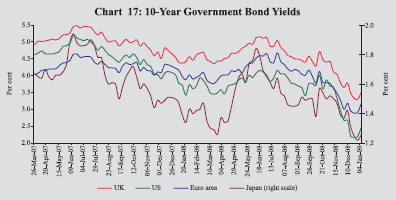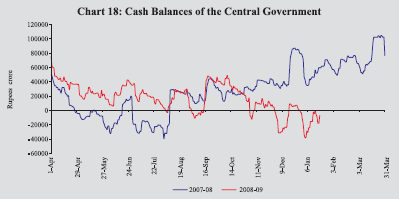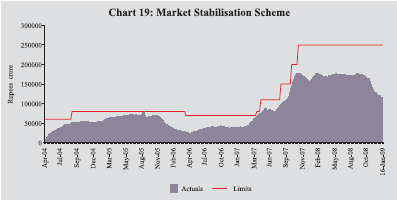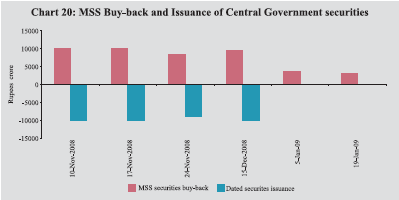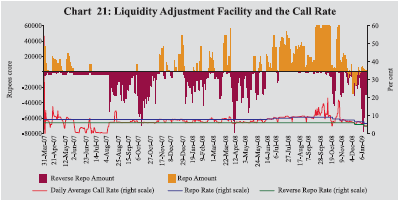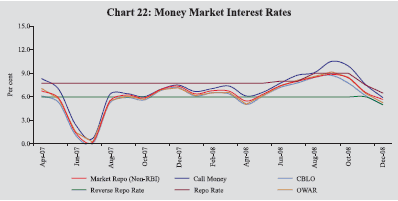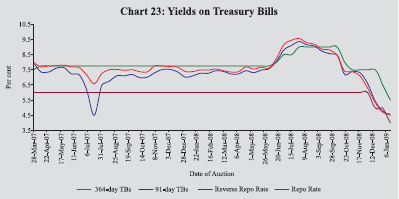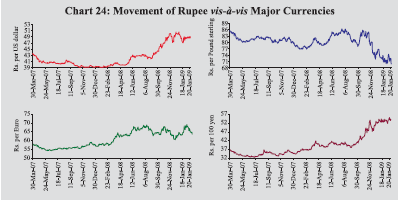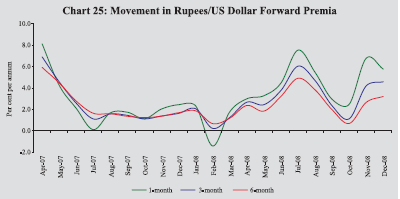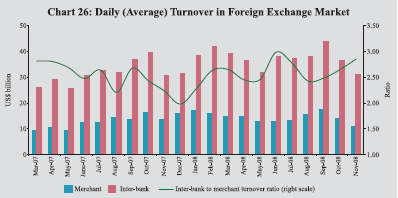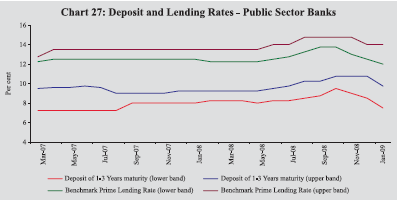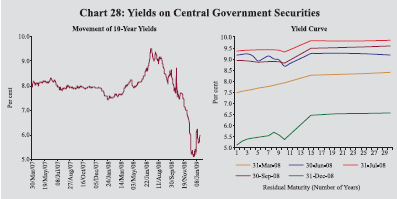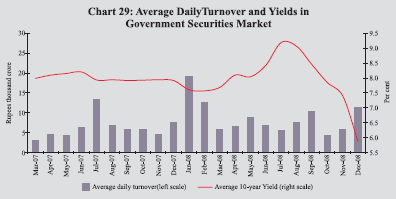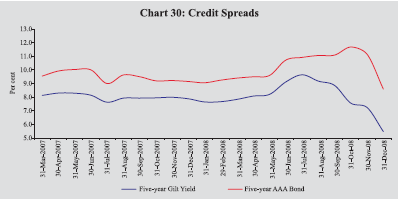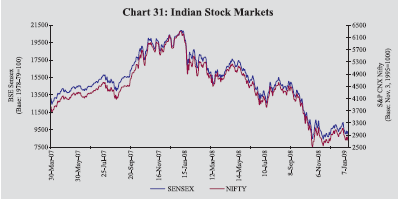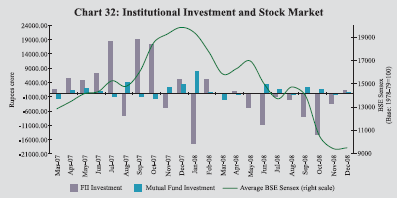V. Financial Markets - RBI - Reserve Bank of India
V. Financial Markets
V.1 The crisis in global financial markets deepened since mid-September 2008, triggered by the collapse of Lehman Brothers followed by the failure of a number of other financial firms across countries. With the counter-party concerns mounting in the context of asset sales driven by the large-scale redemptions, there was a new wave of write-offs of Lehman related investments by the money market funds and other investors, affecting the key players in global financial system. Inter-bank markets froze on valuation concerns. In the wake of credit and money markets witnessing a squeeze and equity prices plummeting, banks and other financial institutions experienced erosion in their access to funding and capital base, owing to accumulating mark to market losses. The pressure on financial markets mounted with the credit spreads widening to record levels and equity prices crashing to historic lows leading to widespread volatility across the market spectrum. The turmoil transcended from credit and money markets to the global financial system more broadly. The contagion also spilled over to the emerging markets, which saw broad-based asset price declines amidst depressed levels of risk appetite. V.2 In consonance with the instability of global financial system, there was a significant deterioration in the global economic outlook reflected in the downward revision of forecasts for both major and emerging market economies. While the government bond yields plummeted in the wake of recession concerns, the yield curves steepened at the short end, mirroring repeated bouts of downward adjustments in policy rates. As a result, authorities in several countries embarked upon an unprecedented wave of policy initiatives to contain systemic risk, arrest the plunge in asset prices and shore up the confidence in the international banking system. V.3 Mounting financial sector problems forced the authorities in a large number of countries to take decisive actions in support of key financial institutions. The central banks took several initiatives to revive money markets which included, inter alia, substantial easing of monetary policy and provision of term funding to a wide range of institutions and against wider collateral list than in the past through introduction of new facilities. In some cases, they provided direct lending to distressed institutions and took other exceptional measures to improve funding conditions in credit markets. The central banks also adopted a co-operative approach to address the problem of foreign currency shortages faced by banks through inter-central bank swap lines. The governments in virtually all advanced economies also announced more comprehensive initiatives to stabilise banking system. While one set of measures was aimed at ensuring bank funding through explicit guarantees on retail deposits, the other set of measures sought to reduce bank leverage through government purchases of distressed assets or capital injections. While these initiatives did help in restoring some level of stability, the financial market conditions remained far from normal during the period October-December 2008. V.4 Financial markets in India came under pressure in mid-September 2008, mainly reflecting the knock-on effects of the disruptions in the major financial centres following the collapse of Lehman Brothers. Liquidity conditions became unduly tight as the period of quarterly tax outflows coincided with the market turmoil and necessitated forex operations by the Reserve Bank to curb excessive volatility. Mirroring the liquidity pressures in the inter-bank market, the rates in the money market rose above the upper bound of the corridor. However, except on a few days, the transactions were not impeded on account of counterparty concerns since the Indian banking system is prudently regulated, well capitalised and free from ';toxic'; assets. In the foreign exchange market, the Indian rupee generally depreciated against major currencies. Indian equity markets witnessed downswings quite in line with trends in major international equity markets. The series of measures swiftly initiated by the Reserve Bank helped to assuage liquidity conditions, while reassuring the market that the Indian banking system continued to be safe and sound, well capitalised and well regulated. International Financial Markets V.5 The developments in the financial markets since the mid-September 2008 could be seen in three phases. The first phase was marked by the takeover of two major US housing finance agencies by the US government and the Lehman bankruptcy. During the second phase, the global financial market turmoil deepened further rapidly as there was widespread crisis of confidence, leading to unprecedented global policy responses that were more broad based and increasingly fast-paced in nature. The final phase began with mid-October 2008, when price patterns started reflecting recession fears amidst markets grappling with uncertainties revolving around new policy initiatives. Money Markets V.6 During September 2008, the funding pressures were particularly evident in respect of cross-currency swap markets where the implied rates for US dollars spiked sharply. The benchmark US investment grade CDX credit default swap index spread jumped by 42 basis points on September 15, 2008 alone, while US high yield spreads rose by 118 basis points. During October 2008, the spread of three-month US dollar Libor over expected future short-term interest rates climbed to a record high of around 370 basis points, mirroring a combination of counter party credit risk and liquidity factors. V.7 Moreover, US markets for other short-term bank debt remained stressed. Commercial paper markets suffered due to redemptions/ reallocations and illiquid secondary markets for these securities. Another source of funding for banks, the market for asset-backed securities became more or less defunct, in turn, affecting banks’ ability to provide new lending. Added to this were widespread redemptions from ‘Prime’ funds, which invest in bank securities. In view of soaring demand for liquid funds in the wake of the contraction in the money market mutual fund sector, global inter-bank markets came under pressure, squeezing banks’ access to short-term funding. Money markets, which were already strained, failed to recuperate, despite massive central bank liquidity injections. As a result, interbank rates spiked to historic highs. The movements in other major markets such as those for euro and sterling funds also showed similar signs, albeit, moderately. Credit spreads in other major markets followed suit and continued to move in tandem with the US markets. V.8 US authorities initiated several measures during October and November 2008. For instance, announcement of temporary guarantee for money market fund investors obviated redemption pressures on money market funds with total assets gradually rising back to their levels before the Lehman breakdown, reaching US$3.6 trillion by early November. Similarly, introduction of Commercial Paper Funding Facility (CPFF), which purchased around US$270 billion helped the US money market funds through turbulence. V.9 With the series of coordinated policy moves by the major central banks, the financial sector spreads rallied back from the peaks reached earlier during the period. Credit spreads came down with recovery in the credit markets. The signs of ease also started reflecting in other markets. After recording a peak at 364 basis points on October 10, 2008, the three-month US dollar Libor-OIS spread witnessed a steady downward trend into November 2008, with spreads reaching around 170 basis points. The euro and sterling Libor-OIS spreads came to see similar pricing movements, indicating a return of stability to the inter-bank markets. However, after an initial decline, spreads on agency debt and MBS soared beyond their peak levels reached in early September. Collateralised lending markets, especially those for repurchase agreements came to witness similar movements. The spreads in the CDS markets widened on increased demand for credit protection, while the corresponding spreads in the financial sector were tightened. While the efforts of the governments and the central banks appeared to be successful in restoring the confidence in global financial markets, the gains across most asset classes turned out to be short-lived. However, the short-term funding markets continued to recover, as the US money market fund assets started stabilising and Libor-OIS spreads began declining, albeit, at levels higher than those prior to the credit crisis. V.10 By mid-October, with the reports of recession, credit markets began anchoring their expectations on ensuing global recession and the associated increase in default related losses. The contraction in bond issuance and bank lending got reflected in the lack of availability of credit for households and non-finance companies. With the release of weak macroeconomic data for the US on October 16, 2008, credit spreads started reverting back to their upward levels. Credit spreads moved to their new highs with the announcement of reallocation of funds under the Troubled Assets Relief Programme for consumer sector in mid-November. It was in late November, that credit spreads started recovering, following the announcement of a support package for Citigroup and measures aimed at supporting the markets for asset backed securities and US agency debt. However, strains persisted with the continued widening of spreads in the troubled sectors such as commercial estate. V.11 As the outlook for economic activity weakened further and inflationary pressures dissipated, on December 10, 2008, the US Federal Reserve cut its Fed Funds rate to a target range of 0 to ¼ per cent. Similarly, Bank of England further cut its official bank rate by 100 basis points in December 2008 and again by 50 basis points to 1.5 per cent on January 8, 2009. Other central banks such as ECB including some EMEs such as China followed suit. Short-term Interest Rates V.12 During the third quarter of 2008-09, short-term interest rates in advanced economies witnessed an easing trend, moving broadly in tandem with cuts in the policy rates on the back of recession concerns (Table 36). In the US, short-term interest rates declined, reflecting liquidity injections and reduction in the fed funds target rate in October and December 2008.
In the UK, short-term interest rates declined, following cuts in the policy rate thrice during October-December 2008 and again on January 8, 2009. Similar trends were witnessed in the Euro area with cuts in ECB policy rate thrice between October-December 2008. Among the EMEs, short-term interest rates generally softened in China, Hong Kong, Malaysia, Singapore and South Korea, hardened in Argentina and Philippines and remained stable in Brazil and Thailand. The central banks in the EMEs - People’s Bank of China, Bank of Korea, Bank of Thailand, etc., effected cuts in the policy rates during the above period. Government Bond Yields V.13 Long-term government bond yields in major advanced economies, which had hardened during the first quarter of 2008-09 declined over the second quarter, reflecting worsening growth expectations and improved near- term inflation outlook. The decline got accentuated during the third quarter. The 10-year government bond yield in the US declined by 156 basis points between October 1, 2008 and January 14, 2009. During the same period, yields on 10-year government papers declined by 105 basis points in UK, 104 basis points in the Euro area and 23 basis points in Japan (Chart 17). Foreign Exchange Markets V.14 While movements in exchange rates partly reflected developments in the interest rates, a combination of three factors illustrates the perceived exchange rate movements in the recent period. First, a general retrenchment from risky assets as part of the ongoing deleveraging process in the financial markets, second, unwinding of currency carry trades with the elevated market volatilities, and third, repatriation of investments, particularly in the US and Japan. The accumulated gains were eroded as the low-yielding currencies appreciated and carry trade returns turned negative. V.15 The widening credit spreads and mounting demand for US dollar funds was reflected in the market for foreign exchange swaps, which witnessed historic high spreads for various countries including emerging market currencies vis-à-vis the US dollar. There were increasing pressures in obtaining US dollar funding in both uncollateralised and collateralised markets. Confronted with the foreign currency shortages, central banks responded by providing foreign currency funding to their counterparties. Alongside, major central banks came to respond with a new round of coordinated measures to address squeeze in the US dollar short-term funding. They signed enlarged currency swap facilities worth US $ 180 billion during October 2008. The use of inter-central bank swap lines, particularly those with the Federal Reserve expanded considerably in both scale and scope. V.16 The US dollar, generally, appreciated against most of the currencies as the US investors were liquidating their positions in overseas equity and bond markets and repatriating the money back to the US. Between end-March 2008 and January 13, 2009, the US dollar appreciated against the euro and Pound sterling. However, the US dollar depreciated largely against the Japanese yen, as a result of unwinding carry trades. Amongst Asian currencies also, the US dollar appreciated against Korean won, Thai Baht, Malaysian ringgit, Indonesian rupiah and Indian rupee but depreciated against Chinese Yuan (Table 37).
Equity Markets V.17 Equity prices plummeted across the major economies, affecting broadly all the major industrial sectors, with volatility soaring across the markets. With the intensification of funding pressures in the global banking system, fall in the share prices was particularly sharp during the early October 2008. Part of the price falls was linked to the hedge funds liquidating positions to meet the increased margin calls. V.18 The recession concerns, which surfaced in late October and November, were reflected in the equity markets with the plunge in global equity markets being the highest than any of the crisis since the 1930s. News relating to negative earnings, tightening lending standards and subdued consumer confidence came to weigh heavily on the major indices. Investment analysts came to lower their forecasts for earnings growth in 2008 and 2009 as the news about worsening macroeconomic outlook stepped in. The corporate prospects worsened with the price of dividend swaps declining sharply, particularly during October. Alongside fall in equity prices, corporate credit spreads also widened further. Falling asset prices also affected the asset portfolios of long-term investors such as pension funds and insurance companies. Notwithstanding further monetary easing by several central banks, global equity markets were down by around 40 per cent by mid-January 2009. Equity markets in most of the developed and emerging economies declined due to concerns over economic slowdown in the US, Europe and Asia and dip in the profit outlook of companies (Table 38). Emerging Markets V.19 Banks in emerging markets, which had been relatively less affected by the strains in the dollar money markets till mid-September 2008, also came to witness funding shortages. During mid-October 2008, emerging markets debt and equities came to witness significant outflows, weakening the equity markets, on the back of concerns about the availability of trade finance and falling risk appetite. Amidst the sharp depreciations in the value of EME
currencies against the US dollar, spreads on sovereign and corporate bonds widened. The asset prices in these countries partly reflected the subdued global macroeconomic prospects, leading to the expectations of lower returns on EME assets. The decline in commodity prices also appeared to have put further pressure on EME commodity exporters. V.20 Central banks in most of the emerging markets conducted outright sales of foreign reserves to cater to their domestic demand for foreign currency funding. Some central banks sought to offer foreign reserves to counterparties under repurchase agreements, while others either modified their existing forex swap facilities or set up new swap facilities. By end-November 2008, emerging credit and equity markets came to recover from late-October levels. However, the adjustments in price/earnings multiples were sharp than those in the major markets, with relative valuations broadly back in line with the historical levels. V.21 Central banks have engaged in continuous close consultation and have cooperated in unprecedented joint actions to reduce strains in financial markets. In order to arrest the rapid erosion of market confidence, ease the funding pressures, restore liquidity in the markets and stablise the banking system, the governments and the central banks in virtually all advanced economies responded with a new array of comprehensive initiatives in quick succession during October and November 2008. These initiatives came in the following forms. First, monetary policy easing by both individual central banks and coordinated international response by the major central banks in the form of an unprecedented rounds of policy rate cuts. Second, provision of cross-border liquidity through swap arrangements by the co-ordination of major central banks. Third, extending the list of eligible collaterals and counterparties and auctioning of term funds through new channels. Fourth, explicit government guarantees on retail deposits and other bank liabilities. Fifth, reducing bank leverage through government purchases of distressed assets or capital injections. Sixth, decisive actions to combat market manipulation and stabilise financial markets, including a temporary ban on short selling of financial stocks. Seventh, measures aimed at facilitating lending to consumer and small business sectors. Finally, rescue packages for restructuring and recapitalisation - guarantees and equity injections aimed at restarting inter-bank lending and replenishing banks’ capital positions. These coordinated moves by the major central banks have been critical in addressing disruptions in the global financial markets and were successful in driving modest improvement in the market sentiments and easing the acute instability across the global banking system (Table 39). V.22 The recent episode of global financial market distress was unprecedented in terms of its magnitude and scale, which has brought several difficult issues to the fore. First, it has raised the issue of appropriateness of structured products and derivatives in the credit markets and their financial stability implications, thereby underscoring a need for eliminating the shortcomings.
Second, there is a need to address regulatory arbitrage, which had encouraged loose practices, hunt for quick yields and non-transparent and risky financial products among private equity funds, structured investment vehicles/ conduits and money market funds, which were highly leveraged and had nexus with the banking system. Third, the emerging lesson undeniably remains that regulations have to keep pace with the innovations and they need to be ahead of the curve, while ensuring concomitantly that such regulations do not throttle innovation. Fourth, it has also raised the issue of suitability of universal banking model that has been adopted widely in recent years. Fifth, the above issues also call for close coordination among various agencies in which the role of banks, regulators, supervisors and fiscal authorities with regard to financial stability needs to be relooked. Sixth, in the wake of unprecedented crisis in the US financial sector and consequent erosion in the confidence, it cannot be inferred that markets and competition do not work, but they do need to be managed and regulated appropriately. The right lesson to draw is that markets and institutions do succumb occasionally to excesses and regulators have to be vigilant, constantly finding the right balance between attenuating risk-taking and inhibiting growth. Seventh, notwithstanding the recent use of innovative and unconventional measures, a more systematic approach would be required to deal with disposition of distressed assets, the degree of protection offered to depositors, and the scale and scope of liquidity support that is offered to institutions and markets. Finally, the recent dip in the global macro economic outlook has further added to the unstable global financial market conditions, thus, reiterating that financial sector has no standing of its own, it derives its strength and resilience from the real economy. Domestic Financial Markets V.24 The Indian financial markets came under pressure from mid-September 2008 reflecting the knock-on effects of the global crises through the monetary, financial and real channels. The contagion was initially felt in the equity market due to reversal of foreign institutional portfolio flows and the concomitant effects on the domestic foreign exchange market and liquidity conditions. The liquidity pressure faced by the mutual funds in the wake of redemption demands affected banks and other segments of the financial sector. Thus, all the segments of the financial market came under pressure which necessitated the Reserve Bank to undertake several measures to augment domestic and foreign exchange liquidity (Annex). The pressure on money markets was reflected in call rates breaching the upper bound of LAF corridor till end-October 2008. In the foreign exchange market, the Indian rupee generally depreciated against major currencies. In the credit market, lending rates of scheduled commercial banks, which witnessed a hardening trend initially, declined during December 2008. Yields softened in the government securities market during the third quarter 2008-09. Following the trends in major international equity markets, Indian equity markets saw a decline during the same period (Table 40). Liquidity Conditions V.25 During 2008-09 so far, liquidity management operations had to swiftly change beginning mid-September 2008 in order to address the sharp changes in the financial environment brought about by the knock-on effects of the severe disruptions in international financial
markets. A holistic account of liquidity management operations is given in Box 1. Cash Management of the Central Government V.26 Commencing the year with a surplus cash balance of Rs.76,686 crore (end-March 2008), built primarily from surplus balances of State Governments which were invested in Treasury Bills, the Central Government used up these balances to meet its expenditure needs and resorted to WMA between August 4, 2008 and August 6, 2008. With inflow of indirect taxes and surplus transferred from the Reserve Bank, the cash balances turned into surplus between August 7, 2008 and September 1, 2008. The Central Government again resorted to WMA during September 2-14, 2008 to meet the mismatches in receipts and expenditure. Surpluses built by advance tax flows in the latter half of September 2008 were utilised to meet the increased expenditure requirement of the Central Government. During the second half of 2008-09 (up to January 19, 2009), the Central Government resorted to WMA on three occasions, viz., November 4-7, 2008, December 1-16, 2008 and December 29, 2008-January 19, 2009. The daily average utilisation of WMA by the Central Government (up to January 19, 2009) was Rs.1,623 crore as compared with Rs.3,196 crore a year ago. Due to additional funding requirements, the Central Government also availed of overdraft (OD) for the first time in the current financial year, during December 5-14, 2008, January 1-11, 2009 and January 16-19, 2009. The daily average of OD was Rs.1,088 crore as compared with Rs.425 crore a year ago (Chart 18). Box 1: Liquidity Management Operations during 2008-09 During most part of the first half of the current fiscal year 2008-09, liquidity management operations were essentially geared towards mopping up of excess domestic liquidity, mainly through CRR hikes, with a view to containing inflationary pressures largely emanating from rising crude and commodity prices. In conjunction, the foreign exchange market operations of the Reserve Bank to contain excessive volatility in the exchange rate also absorbed domestic liquidity and obviated the need for issuing dated securities under MSS. Overnight rates were maintained at the upper end of the corridor during July to mid-September 2008 and the frictional liquidity requirements of the banking system were met through LAF. Beginning mid- September 2008, domestic money and foreign exchange markets came under pressure from the indirect effects of the global financial turmoil. The Reserve Bank’s operations to contain volatility in the foreign exchange market coupled with transient factors like advance tax payments exacerbated the pressure on rupee liquidity. Consequently, overnight rates moved above the upper bound of the LAF corridor. With the abatement of inflationary pressures, rupee liquidity was augmented through, inter alia, reduction in the CRR and a slew of special facilities as detailed in the Annex. The availment under LAF also increased substantially. These apart, MSS buyback auctions were timed to alleviate domestic liquidity pressures. Liquidity Management V.27 During the period April to mid-September 2008, the drying up of capital inflows and the consequent turnaround in the foreign exchange operations of the Reserve Bank from net spot purchases up to May 2008 to net spot sales thereafter (barring August 2008) reduced the generation of domestic liquidity (Table 41). Consequently, the MSS auctions of dated securities were kept in abeyance since end-April 2008 (Chart 19). At the same time, however, the general decline in the cash balances of the Central Government eased systemic liquidity conditions except during advance tax collections around mid-June 2008. On the other hand, against the backdrop of inflationary pressures, CRR was increased (in April, May, July and August) cumulatively by 150 basis points to 9.0 per cent effective August 30, 2008 and the repo rate was raised cumulatively by 125 basis points (in June and July 2008) to 9.0 per cent effective July 30, 2008. Reflecting the impact of these developments, the LAF turned from absorption mode to injection mode after the first week of June 2008. V.28 Beginning mid-September 2008, the bankruptcy/sell out/ restructuring of some of the world’s largest financial institutions brought pressures on the domestic money and foreign exchange markets, in conjunction with temporary local factors such as advance tax outflows. In order to alleviate these pressures, the Reserve Bank initiated a series of measures beginning mid-September 2008 to augment rupee and dollar liquidity (Annex). The average daily net outstanding liquidity injection under LAF was Rs.42,591 crore during September 2008 as compared with Rs. 22,560 crore in the previous month. There were no fresh issuances under the MSS after September 2, 2008 and the actual balances under the MSS was Rs.1,73,804 crore as on September 26, 2008 (Table 42).
V.29 In October 2008, as part of the various measures to augment rupee liquidity, the CRR was reduced by 250 basis points to 6.50 per cent effective from the fortnight beginning October 11, 2008. Deficit liquidity conditions, however,
persisted during October 2008 mainly due to sharp increase in bank credit and festive season currency demand. V.30 On November 1, 2008, another set of monetary measures were announced in view of then prevailing financial conditions, which included: (i) further reduction in CRR by 100 basis points in two stages viz., to 6.0 per cent retrospectively with effect from October 25 and to 5.5 per cent with effect from November 8, 2008; (ii) introduction of a special refinance facility under Section 17 (3B) of the Reserve Bank of India Act to provide further comfort on liquidity and to impart flexibility in liquidity management to banks; (iii) permanent reduction of 100 basis points in SLR to 24 per cent from November 8, 2008 (as against a temporary reduction to the same extent announced on September 16, 2008); and (iv) enhancement of the relaxation in SLR maintenance in the context of the term repo facility from 0.5 per cent to 1.5 per cent of the banks’ NDTL with effect from November 1, 2008. Furthermore, between April 1, 2008-December 31, 2008, the outstanding balances under MSS fell by Rs.49,201 crore to Rs.1,21,353 crore, notwithstanding fresh issuances of Rs.43,500 crore till September 2008. This fall was on account of redemption to the tune of Rs.54,737 crore and buy-backs (during November-December 2008) of Rs.37,964 crore (Chart 20). Reflecting the impact of the various monetary measures, the average daily net outstanding liquidity injection under LAF declined significantly to Rs.8,017 crore during November 2008 from that of Rs.45,612 crore during October 2008. V.31 Liquidity conditions continued to ease during December 2008. The LAF shifted from net injection mode to net absorption mode with effect from December 1, 2008. The average daily net outstanding liquidity absorption under LAF was Rs.22,294 crore during December 2008. V.32 On a review of the prevailing global and domestic macroeconomic situation, the Reserve Bank reduced (a) the CRR by a further 50 basis points to 5.0 per cent effective from the fortnight beginning January 17, 2009, (b) the repo rate by a further 100 basis points to 5.5 per cent and (c) the reverse repo rate by 100 basis points to 4.0 per cent effective from January 5, 2009. The liquidity absorption under LAF on January 22, 2009 was at Rs.54,750 crore. The outstanding balances under the MSS declined further to Rs.1,10,651 crore as on January 19, 2009, mainly reflecting buy-back of Rs.6,580 crore. Money Market V.33 Money market remained, by and large orderly, with call rates remaining generally within the informal corridor of reverse repo and repo rates during the first quarter of 2008-09. The weighted average daily call rate was 6.83 per cent in the first quarter. As detailed in previous section, monetary policy was tightened on the back of inflationary pressues in stages till August 2008 and the call rates hovered around the upper bound of the corridor during the second quarter (upto mid-September 2008). In mid-September, the failure of Lehman Brothers and some other global financial institutions led to freezing of money market activities in major financial centres. The Indian markets were also indirectly affected and the impact on money market rates was magnified as it concided with the period of advance tax outflows from the banking system. Reflecting the tight liquidity conditions, the call money rate moved above the repo rate till the end of September 2008. The weighted average daily call rate was 9.46 per cent in the second quarter. V.34 The pressure on money markets continued to prevail in the beginning of the third quarter of 2008-09, partly on account of the foreign exchange operations of the Reserve Bank undertaken to contain excess volatility. Consequently, the call rate continued to remain above the informal corridor in the first half of October 2008. Subsequently, the call rate declined under the impact of the reduction in the cash reserve ratio (CRR) by 250 basis points to 6.50 per cent with effect from the fortnight beginning October 11, 2008. The call rate again crossed the upper bound of the LAF corridor in the last week of October 2008, partly reflecting the festive season increase in demand for currency. V.35 During the period of market stress, i.e., during mid-September to end-October 2008, out of a total of 47 days, the daily weighted average call rate and the overnight weighted average money market rate (OWAR) crossed the upper bound of the LAF corridor on 36 days and 31 days, respectively (Chart 21). During the same period the call rate averaged 10.56 per cent, while the OWAR averaged lower at 8.98 per cent. V.36 As the demand for currency receded and as the series of measures initiated by the Reserve Bank, including the reduction in the repo rate by a cumulative 150 basis points to 7.5 per cent with effect from November 3, 2008, began to take effect, the weighted average call money rate declined from a high of 19.7 per cent (on October 10, 2008) and mostly remained within the LAF corridor from November 3, 2008 onwards. V.37 Liquidity conditions continued to improve from December 2008 onwards following the reduction of 100 basis points each in repo rate and reverse repo rate to 6.5 per cent and 5.0 per cent, respectively with effect from December 8, 2008. The weighted average daily call rate declined from 9.9 per cent in October 2008 to 7.57 per cent in November 2008. The OWAR has also mostly remained well below the upper bound of the LAF corridor since November 3, 2008. The weighted average daily call rate and the OWAR in December 2008 were placed at 5.92 per cent and 5.22 per cent, respectively. The call money rate declined further with the reduction in the repo rate and reverse repo rate to 5.5 per cent and 4.0 per cent, respectively, effective from January 5, 2009. On January 22, 2009, the weighted average daily call rate and the OWAR were placed at 4.21 per cent and 4.01 per cent, respectively (Chart 22). Interest rates in the collateralised segments of the money market – the market repo (outside the LAF) and the Collateralised Borrowing and Lending Obligation (CBLO) – moved in tandem with but remained below the call rate during the third quarter of 2008-09. V.38 Unlike in the case of some of the other countries, there were no major disruptions in the money market in India during post mid-September 2008, primarily because there was no solvency issue in respect of Indian banks and the prudent SLR prescription provided adequate leeway to the Reserve Bank for meeting their liquidity needs through LAF without diluting the collateral quality. V.39 Special Market Operations (SMO) were conducted by the Reserve Bank from June 2008 till August 2008 to improve the access of public sector oil companies to domestic liquidity and alleviate the lumpy demand in the foreign exchange market in the context of the unprecedented increase in international oil prices. The SMO was an exceptional measure for minimising potential adverse consequences for financial markets in a transparent manner. In this phase, the SMOs were liquidity neutral since the settlement dates of the foreign exchange transactions and transactions in oil bonds were synchronised. SMOs were resumed but with calibrated provision of US dollars from November 24, 2008 and continued till January 2, 2009. Certificates of Deposit V.40 The outstanding amount of certificates of deposit (CDs) issued by scheduled commercial banks (SCBs) increased from Rs.1,47,792 crore at end-March 2008 to Rs.1,78,280 crore as on September 12, 2008. Thereafter, the outstanding amount declined to Rs.1,51,214 crore as on December 19, 2008 reflecting the pressures on domestic financial markets. The outstanding amount constituted 5.2 per cent of aggregate deposit of CD-issuing banks with a significant inter-bank variation as on December 19, 2008. During April-December 2008, the average issuance of CDs was placed at Rs.6,253 crore as compared with Rs.5,780 crore in the corresponding period of previous year and Rs.6,709 crore during 2007-08 (full year). Most of the CDs issued were of more than six months duration. The weighted average discount rate (WADR) of CDs declined from 10.0 per cent at end-March 2008 to 9.16 per cent at end-June 2008, but increased steadily to 12.57 per cent on October 10, 2008. Thereafter, the WADR declined to 8.85 per cent as on December 19, 2008 in tandem with movements in other money market rates (Table 43).
Commercial Paper V.41 The outstanding amount of commercial paper issued by corporates increased gradually from Rs.32,592 crore at end-March 2008 to Rs.55,036 crore at end-August 2008 in line with the seasonal pattern observed in case of CP issuances. The average issuance of CP during April-December 2008 was at Rs.4,643 crore as compared with Rs.4,033 crore in the corresponding period of previous year and Rs.4,153 crore during 2007-08 (full year). Leasing and Finance Companies continued to be the major issuers of CP, followed by ‘manufacturing and other companies’ and financial institutions (Table 44). As earlier, CP issuance was dominated by the prime-rated companies. The WADR on CP declined from 10.38 per cent on March 31, 2008 to 8.57 per cent as at mid-May 2008. Thereafter it increased steadily to 14.17 per cent as at end-October 2008 but again declined to 10.98 per cent as at end-December 2008. The most preferred tenor of CP issuance was ‘more than 180 days’. V.42 Starting from mid-September 2008, the outstanding amount of CPs declined continuously reflecting disturbances in financial markets and stood at Rs.38,055 crore as at end-December 2008. Issuing & Paying Agents (IPAs) have reported defaults in repayments of CPs issued by two realty companies in recent months. Also, the differential in the WADR of CP vis-a-vis CDs, has widened reflecting preference for bank CDs in the recent period. Treasury Bills V.43 During the third quarter of 2008-09 primary market yields on Treasury Bills (TBs) showed a declining trend on account of various measures taken by the Reserve Bank to enhance liquidity in the system and cuts in policy rates (Table 45 and Chart 23). Thus, movements in Treasury Bill yields have corresponded to monetary policy changes. The yield spread between 364-day and 91-day TB was -1 basis point in December 2008 (7 basis points in March 2008).
Foreign Exchange Market V.44 The rupee moved in the range of Rs.39.89-50.53 per US dollar during the financial year 2008-09 so far (up to January 20, 2009). The rupee showed a depreciating trend during the second quarter of 2008-09, which started in the beginning of current financial year. The rupee remained around the level of Rs.43 per US dollar during third week of May 2008 to second week of August 2008, depreciated thereafter sharply mainly on the back of widening trade deficit, capital outflows and strengthening of US dollar vis-à-vis other major currencies. The rupee/US dollar exchange rate, which was Rs. 39.99 per dollar at end-March 2008, fell to its lowest level at Rs. 50.53 per dollar as on December 02, 2008, before recovering to Rs. 49.00 per dollar as on January 20, 2009. As on January 20, 2009, the Indian rupee depreciated by 18.4 per cent over its level on March 31, 2008. Over the same period, the rupee experienced a depreciation of 1.0 per cent against the euro, 26.1 per cent against the Japanese yen and 20.5 per cent against the Chinese yuan. However, the rupee showed an appreciation of 13.9 per cent against Pound sterling (Chart 24). V.45 After witnessing appreciation during 2007-08 on account of large capital inflows, the trade weights based nominal effective exchange rate (NEER) and real effective exchange rate (REER) of the Indian rupee depreciated during 2008-09 so far. The 36-currency trade weighted NEER and REER depreciated by 7.8 per cent and 9.4 per cent, respectively, between March 2008 and October 2008 as against an appreciation of 9.4 per cent and 5.9 per cent, respectively, during the corresponding period of the previous year, reflecting widened trade deficit and moderation in capital flows. Over the same period, the 6-currency trade weighted NEER and REER of the rupee depreciated by 11.8 per cent and 7.6 per cent, respectively, as against an appreciation of 7.4 per cent and 7.8 per cent, respectively during the corresponding period of previous year. As on January 20, 2009, the 6-currency trade weighted NEER and REER of the rupee indicated a depreciation of 10.7 per cent and 10.1 per cent, respectively, over its end-March 2008 level (Table 46). V.46 Forward premia increased during November-December 2008 on the back of reduced interest rates in the domestic market and declined hedging requirements by the exporters as a result of rupee depreciation and decreased export and import performance. As on January 16, 2009, the one month, three month and six
month premia were at 4.1 per cent, 3.0 per cent and 2.3 per cent, respectively (Chart 25). V.47 The daily average turnover in the foreign exchange market has decreased to US $ 46.1 billion during the third quarter of 2008-09 (October-November) as compared with US $ 50.2 billion during the corresponding quarter of the previous year. The daily average turnover in inter-bank and merchant segments of the foreign exchange market were US $ 33.8 billion and US $ 12.3 billion, respectively, during the third quarter of the current financial year. The ratio of inter-bank to merchant turnover remained at 2.7 during the third quarter of 2008-09 (Chart 26). Credit Market V.48 Benchmark prime lending rates (BPLRs) hardened during October 2008 over the levels in March 2008. In response to the Reserve Bank’s measures taken since mid-September 2008, most of the PSBs have reduced their BPLRs from November 2008. Accordingly, the BPLR of PSBs decreased from the range of 13.75-14.75 per cent in September 2008 to a range of 12.00-14.00 per cent in January 2009 (up to January 20, 2009). Similarly, the private sector banks also reduced their BPLR from the range of 13.75-17.75 per cent to 13.00-17.25 per cent during the same period (Table 47 and Chart 27).
Government Securities Market Central Government Securities V.49 Gross and net market borrowings (dated securities and 364-day Treasury Bills) of the Central Government during 2008-09 (up to January 19, 2009) amounted to Rs.2,22,154 crore and Rs.1,51,697 crore, respectively, accounting for 89.9 per cent and 89.0 per cent of the estimated market borrowings for the year (Table 48). During the corresponding period of the previous year, gross and net borrowings accounted for 91.6 per cent and 93.1 per cent, respectively, of the estimated market borrowing for the year. During the first half of the year, all the issuances of dated securities were in accordance with the issuance calendar for the first half of the year, except on two occasions. During the second half of the year, two auctions scheduled for the month of October for dated securities amounting to Rs.20,000 crore were cancelled in view of the prevailing liquidity conditions and cut in repo rate. This amount was raised in the subsequent auctions. The issuance calendar for dated securities for the second half of 2008-09 (October-March), which was released on September 26, 2008 in consultation with the Government of India to raise Rs.39,000 crore, was revised on two occasions in the light of additional expenditure requirement of the Central Government following passage of the first and second supplementary demand for grants and the concomitant need to raise additional resources. Accordingly, two indicative calendars were issued on December 5, 2008 and January 6, 2009 –the latter superseding the former – in consultation with the Government of India, for raising an additional Rs.70,000 crore over and above the budgeted amount during the period from December 1, 2008 to March 31, 2009. All auctions during 2008-09 (up to January 19, 2009) were for reissuance of existing securities, barring three new issues. There was a devolvement of Rs.4,764 crore on primary dealers (PDs) during 2008-09 (up to January 19, 2009) as compared with devolvement of Rs.957 crore during the corresponding period of the previous year.
The bid-cover ratio ranged between 1.22 and 3.94. The weighted average maturity of dated securities issued during 2008-09 (up to January 19, 2009) at 14.59 years was marginally higher than 14.57 years during the corresponding period of the previous year. The weighted average yield of dated securities issued during 2008-09 (up to January 19, 2009) at 8.03 per cent was lower than 8.15 per cent during the corresponding period of last year. V.50 The notified amounts for 91-day, 182-day and 364-day Treasury Bills were kept unchanged in the issuance calendar for 2008-09. However, the notified amounts (excluding MSS) in respect of all three Treasury Bills were raised during the course of the year to finance the temporary cash mismatch, inter alia, arising from the expenditure on farmers’ debt waiver scheme. Thus, an additional amount of Rs.1,19,500 crore (Rs.69,000 crore, net) was raised over and above the notified amount in the calendar as on January 19, 2009. State Government Securities V.51 The provisional net allocation under market borrowing programme of the State Governments and the Union Territory of Puducherry for 2008-09 is placed at Rs.49,539 crore. Taking into account repayments of Rs.14,371 crore and additional allocation of Rs.13,859 crore, the gross market borrowings of the State Governments are estimated at Rs.77,770 crore. During the current year, so far (up to January 19, 2009), 22 State Governments and the Union Territory of Puducherry raised a total amount of Rs.52,843 crore through auctions (Table 49) with cut-off yields in the
range 5.80-9.90 per cent as compared with Rs.39,671 crore by 22 State Governments (cut-off yields in the range 8.00-8.90 per cent) during the corresponding period of the previous year. The weighted average interest rate on market loans eased to 7.74 per cent during 2008-09 (up to January 19, 2009) from 8.35 per cent during the corresponding period of 2007-08. The spreads of State Government securities over the yields of Central Government securities of corresponding maturity ranged between 21 and 110 basis points as compared with 19 and 90 basis points during the corresponding period of 2007-08. Secondary Market V.52 Yields in the government securities market hardened at the beginning of the current financial year with the 10-year yield reaching 8.23 per cent on April 21, 2008 from 7.93 per cent on end-March 2008 in response to higher reading in domestic inflation (Chart 28). Subsequently, heightened inflationary expectations emanating from the sharp increase in global commodity prices and concomitant policy responses in the form of hike in CRR and repo rate, led to further hardening of yields. The 10-year yield consequently rose to 9.51 per cent on July 15, 2008. V.53 Yields in the government securities market generally eased from end-July till around mid-September 2008 following the reduction in inflationary pressures tracking softening crude oil prices. The yields, however, hardened in the second fortnight of September 2008 as the liquidity conditions tightened mainly reflecting advance tax outflows in conjunction with the impact of adverse developments in international financial markets. The 10-year yield increased from 8.08 per cent to 8.63 per cent over the second half of end-September 2008. Subsequently, the yields eased substantially in tandem with the liquidity enhancing measures, including cuts in CRR, reduction in policy rates and the sharp decline in WPI. The 10-year G-sec yield stood at 5.87 per cent as at January 23, 2009. V.54 During the year, the Government securities yield curve moved upwards and peaked by end-July 2008. Thereafter, the yield curve has moved downwards. The yield curve remains flat beyond 15 years. A notable feature was the inversion of the yield curve with the 10-year yield falling below that of the sub-10 year segment. This is attributable to the concentration of trading around the 10 year tenor as well as the impact of monetary policy actions at the short end. Resultantly, the spread between 1-year and 10-year yields was 25 basis points as against the spread of 35 basis points between the 1-year and 5-year yields, and 145 basis points between 1-year and 30-year yields, as at end-December 2008. V.55 The daily turnover in the Central Government securities market averaged Rs.7,213 crore during October-December 2008, which was around 7.0 per cent lower than that in the preceding quarter (Chart 29). V.56 The yield on 5-year AAA-rated corporate bonds, which witnessed a hardening trend during the second quarter, came to soften during the third quarter of 2008-09. The credit spread between the yields on 5-year AAA-rated bonds and 5-year government securities has narrowed on the back of easing liquidity conditions (Chart 30). Equity Market Primary Market V.57 The primary market segment of the domestic capital market witnessed a weak trend during the third quarter of 2008-09 so far. Cumulatively, resources raised through public issues declined sharply to Rs.14,007 crore during April-December 2008 from Rs.49,215 crore during the corresponding period of 2007. The number of issues also declined considerably from 91 to 40 (Table 50). Out of 40 issues during April-December 2008, 20 were initial public offerings (IPOs) issued by private sector companies, constituting 14.3 per cent of total resource mobilisation. Furthermore, all the issues during April-December 2008 were equity issues by private non-financial companies except one by private-financial company. The average size of public issues declined considerably from Rs.540.8 crore during April-December 2007 to Rs.350.2 crore during April-December 2008. V.58 Mobilisation of resources through private placement declined by 15.7 per cent to Rs. 79,594 crore during April-September 2008 (period for which latest data are available) as against an increase of 25.6 per cent during April-September 2007. Public sector entities accounted for 51.5 per cent of total mobilisation as compared with 38.5 per cent of total mobilisation during the corresponding period of last year. Resource mobilisation through financial intermediaries (both from public and private sector) registered a decline of 34.8 per cent over the corresponding period of last year, accounting for 50.9 per cent of the total mobilisation during April-September 2008. Resources raised by non-financial intermediaries also registered a decline of 21.1 per cent (49.1 per cent of total resource mobilisation) during April-September 2008 over the corresponding period of last year. V.59 During April-December 2008, the resources raised through Euro issues –American Depository Receipts (ADRs) and Global Depository Receipts (GDRs) – by Indian corporates declined considerably by 81.2 per cent to Rs.4,686 crore as compared with the corresponding period of the previous year. All the Euro issues were GDR issues during April-December 2008. V.60 During April-December 2008, net resource mobilisation by mutual funds indicated an outflow of Rs.30,432 crore compared to an inflow of Rs.1,23,993 crore during April-December 2007 (Table 51). Scheme-wise, during April-December 2008, while income/debt-oriented schemes witnessed a net outflow of Rs.34,601 crore, growth/equity-oriented schemes registered a net inflow of
Rs.3,087 crore. The outflow may primarily be attributed to the uncertain conditions in the stock markets, redemption pressures from banks and corporates due to tight liquidity conditions since June 2008 and payment of third instalment of advance corporate tax by mid-December 2008. Secondary Market V.61 The domestic stock markets remained weak and volatile during the third quarter of 2008-09. The markets recorded substantial losses due to downward trend in international equity markets on reports of the US, Europe and Japan slipping into recession, decline in
commodity prices, traces of slowdown in Indian economy with reports of decline in exports for October 2008, lower industrial growth for April-September 2008 and lower indirect tax collections for October 2008, deceleration in the second quarter corporate earnings, fall in the value of rupee against the US dollar and substantial net sales by FIIs in the Indian equity market. Both the BSE Sensex and the S&P CNX Nifty closed lower at 9101 and 2797 on January 20, 2009, both registering loss of 40.1 per cent over end-March 2008 (Chart 31). V.62 According to the data released by the Securities and Exchange Board of India (SEBI), FIIs have made net sales of Rs.43,782 crore (US $ 10.9 billion) in the Indian equity market during 2008-09 so far (up to January 16, 2009) as against net purchases of Rs.64,776 crore (US $15.8 billion) during the corresponding period of the previous year (Chart 32). Mutual funds, on the other hand, have made net purchases of Rs.6,043 crore during 2008-09 so far (up to January 16, 2009) as compared with net purchases of Rs.9,598 crore during the corresponding period of last year. V.63 The sectoral indices witnessed selling pressure across the board during the current financial year so far (up to January 20, 2009). The major losers among the sectoral indices were metal, capital goods, consumer durables, auto, oil and gas, IT, banking, PSU, healthcare and FMCG (Table 52).
V.64 In line with the downward trend in stock prices, the price-earning (P/E) ratio of the 30 scrips included in the BSE Sensex declined from 20.1 at end-March 2008 to 12.4 at end-December 2008. The market capitalisation of the BSE also declined by 38.8 per cent between end-March 2008 and end-December 2008. The turnover of BSE and NSE in the cash segment during April-December 2008 also declined by 24.4 per cent over that in the corresponding period of 2007. The turnover in the derivative segment of BSE and NSE also declined by 4.7 per cent during April-December 2008 over the corresponding period of the previous year. The volatility in the stock market measured as coefficient of variation, also increased during April-December 2008 (Table 53).
|
|||||||||||||||||||||||||||||||||||||||||||||||||||||||||||||||||||||||||||||||||||||||||||||||||||||||||||||||||||||||||||||||||||||||||||||||||||||||||||||||||||||||||||||||||||||||||||||||||||||||||||||||||||||||||||||||||||||||||||||||||||||||||||||||||||||||||||||||||||||||||||||||||||||||||||||||||||||||||||||||||||||||||||||||||||||||||||||||||||||||||||||||||||||||||||||||||||||||||||||||||||||||||||||||||||||||||||||||||||||||||||||||||||||||||||||||||||||||||||||||||||||||||||||||||||||||||||||||||||||||||||||||||||||||||||||||||||||||||||||||||||||||||||||||||||||||||||||||||||||||||||||||||||||||||||||||||||||||||||||||||||||||||||||||||||||||||||||||||||||||||||||||||||||||||||||||||||||||||||||||||||||||||||||||||||||||||||||||||||||||||||||||||||||||||||||||||||||||||||||||||||||||||||||||||||||||||||||||||||||||||||||||||||||||||||||||||||||||||||||||||||||||||||||||||||||||||||||||||||||||||||||||||||||||||||||||||||||||||||||||||||||||||||||||||||||||||||||||||||||||













